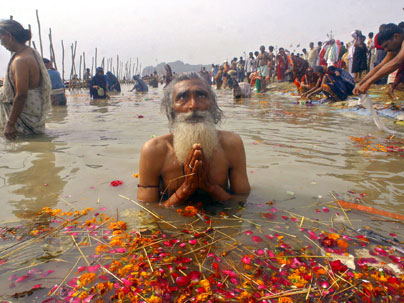
Water pollution in India is dangerous because it disrupts biodiversity by harming and killing both animals and humans.
The increase in population in India has caused problems in trying to meet the needs of both human and industrial water consumption, exhausting the sewage system and leading to an increase in water pollution. India has a 1.1% annual change in population and has the second largest population in the world with 1.2 billion habitants. Due to the country’s increasing population, Indians have faced problems with proper waste disposal and, subsequently, clean drinking water availability. As a result of poor sewage and disposal systems, many wastes end up in India’s water systems, polluting the water.
Water gets polluted because of the toxic materials that are dumped in water systems. Many of the industries in India, such as sugar, pulp, paper, and distillery industries, are responsible for water pollution because they dispose their untreated wastes in water systems. Tanneries, industries in which animal skin is turned into leather, dump the most harmful toxic wastes into India’s water systems. Kanpur, a city that borders The Ganges River, is known as the Leather City because of its fine and large tanneries; however, they produce nine million liters of industrial waste daily, which they directly dump into the river. Heavy metals found in The Ganges River include chromium (due to its usage in the tanning industry), mercury, and arsenic!
Even though millions of India’s population depend on its water, The Ganges River is one of the most polluted water systems in the world because of religious and social practices and its reception of human waste. Water is the most sacred of the many spiritual symbols of India. The Ganges River is important in Indian culture because of its usage in life and death rituals, and the consumption of its water at weddings. Furthermore, about 78% of the population in India practices Hinduism, a religion that considers The Ganges River holy. As part of their religious practices, Hindus bathe in the river because they believe it to wash away their sins. They also dispose of their loved one’s ashes, and in some cases corpses, in the river. Unfortunately, because India’s sewage system is not effective, much of humans’ wastes end up in this same river. As an effect of all these pollutants, people contract diseases such as cholera, hepatitis, and severe diarrhea, which is the leading cause of death among infants in India.

Aquatic species, such as dolphins and fish, die in the Ganges River and other water systems because of the effect of water pollutants. The Ganges River Dolphin is a subspecies of the South Asian river dolphin, primarily found in the water systems of Nepal, India, and Bangladesh. This species is facing extinction with less than 2,000 dolphins left because the polluted water systems have caused a loss of habitat. This dolphin is facing serious health hazards because of the high levels of toxic chemicals in their bodies. Other species that are found in the Indian Ocean, such as sea turtles and blue whales, are endangered because of these pollutants and loss of habitat.
In addition, when fish eat pollutants, they become a health hazard for the others that eat them. This is a dangerous pattern for both animals and humans. If bigger fish eat the poisoned, smaller fish, water pollutants will poison them as well. If these fish are caught to eat, they become a hazard for the human who eats them. Eating fish that lived in polluted waters can cause food poisoning such as Shigella, a bacteria that can contaminate any food that has been in contact with contaminated water. The symptoms include abdominal cramps, diarrhea, fever, vomiting, and weakness.
The close ties to religion and lack of rule of law have been a burden to reducing water pollution. In India, Secularism means that religious laws are tied to state laws. Since there is no clear separation of religion and state, Indians must find another way to improve the problem of water pollution. India’s independence leader, Mahatma Gandhi insisted that there can be ‘no politics without religion’, and that the post-Independence Indian state should be ‘secular’. Nonetheless, India has focused on keeping the tie between state and religion, shown in the resistance of citizens to programs such as the Ganga Action Plan to clean up The Ganges River.

A way to ameliorate the problem of water pollution in India is to encourage recycling, modify the sewage systems, and pass laws that will modify tanneries’ practice and agricultural waste. By recycling and reusing items, waste will significantly decrease and there will be no need to deposit it on the country’s rivers. In addition, the fixing of India’s sewage systems should be prioritized so families’ wastes stop polluting the country’s water systems, especially The Ganges River. The government should also pass laws that prohibit the direct discard of tanneries’ toxic waste to The Ganges River; these industries should find better ways to dispose of unwanted material or should not be able to carry out their business. In terms of agriculture, a sustainable method of agriculture that relies less on artificial fertilizers should be enforced. This way, fewer chemicals will end up in India’s water systems and the water will be safe to drink and bathe in.
-Fabiola Aquino
Darian, Steven G., The Ganges in Myth and History. United Sates: The University Press of Hawaii, 2001. Print.
Lal, Vinay, Political Hinduism: The Religious Imagination in Public Spheres. India: Oxford University Press, 2009. Print.
Brooks, Nina. “Imminent Water Crisis in India.” The Arlington Institute. 2007. n.d. Web. 01 Nov 2017. http://www.arlingtoninstitute.org/wbp/global-water-crisis/606
“Industrial Waste Management.” Ganga Action Parivar. n.d. Web. 01 Nov 2017.http://www.gangaaction.org/actions/issues/industrial-waste-management/
“Ganges River Dolphin.” World Wild Life. n.d. Web. 01 Nov 2017.https://www.worldwildlife.org/species/ganges-river-dolphin
